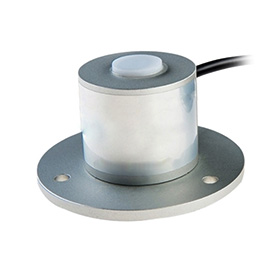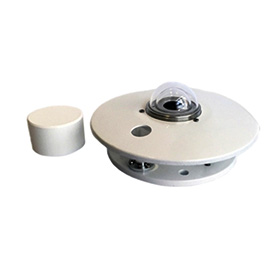Radiation Sensor Buying Guide
Radiation sensor adopts photoelectric principle and can be used to measure the total radiation value under sunlight. The radiation sensor uses high-precision photosensitive elements, wide spectrum absorption, high absorption in the full spectrum range, and good stability. A dust cover with a light transmittance of up to 95% is installed outside the sensing element, and the dust cover is specially treated to reduce dust adsorption can effectively prevent environmental factors from interfering with internal components, and can more accurately measure solar radiation.
There are many kinds of radiation sensors, so how do we find the right one among many kinds of sensors? In the following, ATO store will help you choose the right radiation sensor.
First of all, we should know the types of radiation sensor.
PAR Sensor
 Photosynthetically active radiation sensors are designed to measure light intensity at frequencies associated with photosynthesis. ATO PAR sensor has a measurement range of 400-700 or 350-1100nm. This par sensor can be used alone for outdoor monitoring of radiation driving photosynthesis, or it can be used with a fixed weather station. Get accurate and cost-effective measurements of photosynthetically active radiation (PAR) from all light sources used to grow plants. The PAR sensor adopts the principle of photoelectric induction. The working principle of the PAR sensor: when there is light, a voltage signal proportional to the intensity of the incident radiation is generated, and its sensitivity is proportional to the cosine of the direct angle of the incident light.
Photosynthetically active radiation sensors are designed to measure light intensity at frequencies associated with photosynthesis. ATO PAR sensor has a measurement range of 400-700 or 350-1100nm. This par sensor can be used alone for outdoor monitoring of radiation driving photosynthesis, or it can be used with a fixed weather station. Get accurate and cost-effective measurements of photosynthetically active radiation (PAR) from all light sources used to grow plants. The PAR sensor adopts the principle of photoelectric induction. The working principle of the PAR sensor: when there is light, a voltage signal proportional to the intensity of the incident radiation is generated, and its sensitivity is proportional to the cosine of the direct angle of the incident light.
Pyranometer Sensor
 It uses the thermoelectric principle and can measure solar radiation with a spectral range of 300-3000nm. A desiccant-filled drying cartridge prevents dew from forming on the inner sides of the domes. A bubble level and adjusting leveling screws enable the sensor to be leveled without using a leveling base. The accuracy of this sensor is very high and it supports inspection. This pyranometer can be widely used in solar energy utilization, weather station, agriculture, building material aging and air pollution and other departments to measure solar radiation energy. Our pyranometer sensor based thermopile principle, with high sensitivity. Pyranometer price is affordable, high quality radiation sensor suits for harsh environment. It can be used safely.
It uses the thermoelectric principle and can measure solar radiation with a spectral range of 300-3000nm. A desiccant-filled drying cartridge prevents dew from forming on the inner sides of the domes. A bubble level and adjusting leveling screws enable the sensor to be leveled without using a leveling base. The accuracy of this sensor is very high and it supports inspection. This pyranometer can be widely used in solar energy utilization, weather station, agriculture, building material aging and air pollution and other departments to measure solar radiation energy. Our pyranometer sensor based thermopile principle, with high sensitivity. Pyranometer price is affordable, high quality radiation sensor suits for harsh environment. It can be used safely.
Solar Radiation Sensor
 It is commonly used on weather stations to protect sensors from the sun and rain. Due to the dense ventilation holes around the radiation shield, the shield can ensure that users get more accurate measurement results. The solar radiation shield has built-in multiple sensors, which can measure temperature, humidity, light, noise, atmospheric pressure, PM2.5, PM10, CO2, and other elements at the same time. This solar radiation shield can protect the built-in sensor from direct solar radiation and sun reflection from the ground. The high-strength anti-ultraviolet material can make solar radiation sensor work in rain, snow, strong wind or harsh outdoor environment for a long time. Low thermal conductivity, avoiding measurement errors caused by direct sunlight.
It is commonly used on weather stations to protect sensors from the sun and rain. Due to the dense ventilation holes around the radiation shield, the shield can ensure that users get more accurate measurement results. The solar radiation shield has built-in multiple sensors, which can measure temperature, humidity, light, noise, atmospheric pressure, PM2.5, PM10, CO2, and other elements at the same time. This solar radiation shield can protect the built-in sensor from direct solar radiation and sun reflection from the ground. The high-strength anti-ultraviolet material can make solar radiation sensor work in rain, snow, strong wind or harsh outdoor environment for a long time. Low thermal conductivity, avoiding measurement errors caused by direct sunlight.
UV Radiation Sensor
 UV radiation sensors measure the power or intensity of incident ultraviolet (UV) radiation. They are used for determining exposure to ultraviolet radiation in a laboratory or environmental setting. It can use photosensitive elements to convert ultraviolet signals into measurable electrical signals through photovoltaic mode and light guide mode. The circuit of our UV radiation sensor adopts the industrial-grade microprocessor chip and the high-precision ultraviolet sensor to ensure the excellent reliability and high precision of the product. Our ultraviolet rays sensor adopt a UV measuring device that is highly sensitive to 280-400 nm to accurately measure the UV intensity. The top is made of high-quality light-transmitting materials, with high ultraviolet transmission.
UV radiation sensors measure the power or intensity of incident ultraviolet (UV) radiation. They are used for determining exposure to ultraviolet radiation in a laboratory or environmental setting. It can use photosensitive elements to convert ultraviolet signals into measurable electrical signals through photovoltaic mode and light guide mode. The circuit of our UV radiation sensor adopts the industrial-grade microprocessor chip and the high-precision ultraviolet sensor to ensure the excellent reliability and high precision of the product. Our ultraviolet rays sensor adopt a UV measuring device that is highly sensitive to 280-400 nm to accurately measure the UV intensity. The top is made of high-quality light-transmitting materials, with high ultraviolet transmission.
After knowing the types of radiation sensor, you should have a clear idea. There is no problem in selecting the appropriate radiation sensor through the brief introduction. Please contact us as soon as possible.
Tips For Choosing Radiation Sensor:
- Sensitivity. In general, the more sensitive the radiation sensor is in the linear range of the sensor, the better. Because only when the sensitivity is high, the value of the output signal corresponding to the measured change is relatively large, which is conducive to signal processing. However, it should be noted that the sensitivity of the sensor is high, and the external noise that has nothing to do with the measurement is easy to be mixed in, and will also be amplified by the amplification system, affecting the measurement accuracy. Therefore, it is required that the sensor itself should have a high signal-to-noise ratio to minimize the interference signal introduced from the outside.
- Frequency Response. The frequency response characteristic of the sensor determines the frequency range to be measured and must be maintained without distortion within the allowable frequency range. In fact, there is always a delay in the response of the sensor, and the shorter the delay, the better. The higher the frequency response of the sensor, the wider the frequency range of the signal can be measured.
- Range and Accuracy. Precision is an important performance index of radiation sensor, it is related to the whole measurement system measurement accuracy of an important link. However, the accuracy of the sensor is restricted by the range, generally the larger the range, the lower the accuracy, but the high precision sensor is likely to be insufficient, so it leads to the high precision and large range sensor is very expensive. So we need to adjust the relationship between them properly when choosing.

